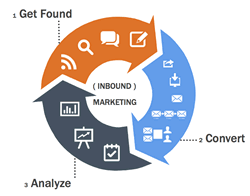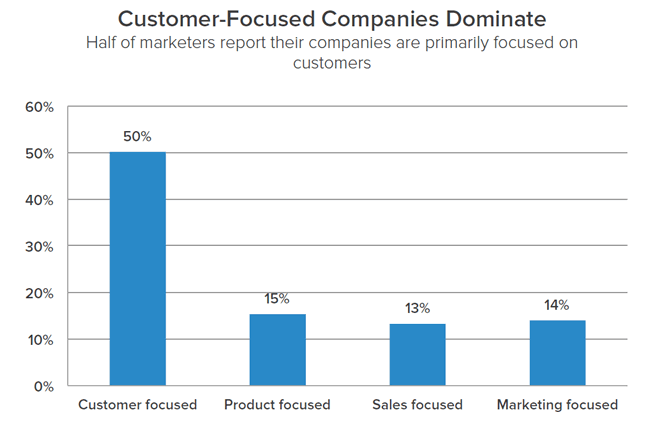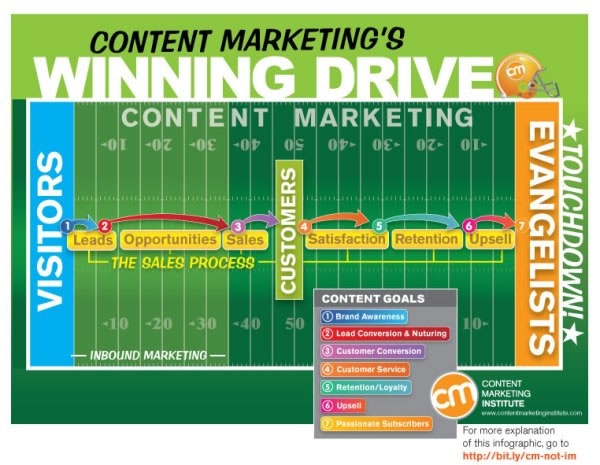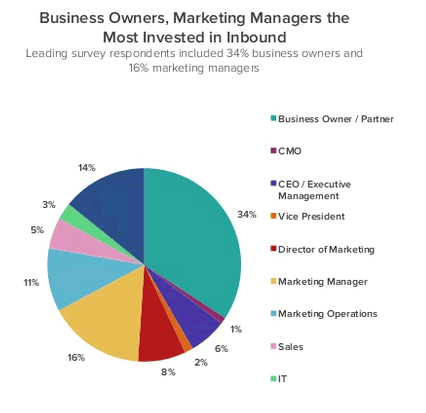When defining content marketing, we like to use a rather pragmatic, holistic and customer-centric content approach. A relevant and optimized use of content is essential in all marketing tactics: from email marketing to social media marketing and inbound marketing. A look at inbound marketing and how it is related with content marketing.

Content has always been essential. What has evolved is the way winning businesses use it in a systematic, consistent and customer-centric way by looking at content from a more mature and ‘strategic’ view and that view by definition revolves around customers and target audiences in the broadest sense.
Just as is the case with content marketing, social media marketing and inbound marketing are umbrella terms and sometimes for marketers it’s difficult to see how they can be used in an integrated way for several business goals and – more importantly – customer goals.
Far more important than what content marketing, inbound marketing, social media marketing, etc. “are” and how they overlap (let alone, than getting dogmatic about them), is the question how you can create business value by creating customer value, using all ‘tactics’ in a smart, integrated and customer-centric way. That’s our real question.
However, as marketers we get confronted with all these terms and the debates about them. Many people that are active in inbound marketing, for instance, classify several forms of content in the average content marketing strategy as inbound marketing. But content marketers will often include most inbound marketing tactics as content marketing and see content marketing as a broader term, which it partially really is. Or something like that.
In fact, in a way everyone is right. But does it really matter? Yes and no:
- Yes because you hear and use those terms and each year there is a report on the state of inbound marketing (and many on the state of content marketing) report but most of all because it’s good to understand what they can do for your business and customers.
- No, because in the end there is only one kind of marketing that matters: the kind that brings in new customers, provides great customer experiences, makes customers more than happy and ensures growth, innovation and so much more. And that’s nearly always integrated/connected and customer-centric marketing.
So, regardless of all the debates, let’s take a look at the term inbound marketing, some tactics it covers (even if it’s open for debate, for instance regarding content marketing) and some key benefits and suggestions.
Behind the idea of inbound marketing: the changing buyer’s journey
Digital has given consumers more power to find the information they are looking for, when and where it suits them best and digital channels are increasingly used in all stages of the buyer’s journey.
Furthermore, people control how they interact with businesses, although that evolution really started a long time ago. Being found or helping people to find what they seek is the key to success in an era where interruption marketing techniques become less appreciated. At least, that’s the idea behind inbound marketing. The truth is that in some cases more or less interruptive tactics still work very fine. Good old tactics such as email marketing still work very well too. But you get the idea: it’s increasingly about being found. The best way to look at it: mix it all, in function of your customer’s preferences. And, finally, there is also this phenomenon on a digitally connected prosumer.
Probably the main reason why the term inbound marketing worked well – on top of the promotion of it by “inventor” HubSpot – is the fact that buyers contact sales reps much later than they used to. They consult their peers and networks (offline and online, social media), websites, search engines, webinars and all these other information sources we traditionally classify as content marketing. Obviously, depending on the nature of the purchase, the type of product, the buyer personas and much more, people also still visit tradeshows or go to shops. But in general they’re more informed and they contact your sales reps later if they contact them at all. So, it’s more about being found than it used to be, simply said. The fact that buyers are “empowered” as it’s called, also is one of the key drivers of content marketing.

Inbound marketing is an umbrella term that groups several tactics and processes, focusing on that ‘being found’ dimension although HubSpot now defines it more as a holistic and integrated approach or strategy. Holistic is an expensive word that I like a lot but is somewhat overused lately and in the end, simply means customer-centric and channel-agnostic, other expensive words that do depict many important marketing realities however.
I guess it’s not a secret anymore that customer-centric marketing is important. Should we call it connected marketing? Agile marketing? Integrated marketing? Who cares? On top of common sense, we have many studies, from very high-end and vertical to very simple proving it. HubSpot’s latest state of inbound marketing report, for instance, found that customer-centric or ‘customer-focused’ companies “do better”. Truth is they always have but it took – and still takes – many businesses a very long time to 1) see that and 2) make it happen.
Inbound marketing is very much about leads, marketing automation, integration and closing the loop with other departments such as sales now, more than about tactics (as the offering of HubSpot evolved).
Some marketing tactics that are typically categorized as inbound marketing:
- Social media marketing that, depending on the goals, needs content
- Some forms of content marketing
- Organic search engine marketing, a.k.a. Search Engine Optimization (SEO), which is increasingly about content, intent, engagement and social signals
- PPC advertising
- Corporate blogging
- Permission-based email marketing (a tactic where folks know everything about headlines and persuasive content)
- Etc.
You immediately see the issue with some forms of content marketing which is really defined as a set of tactics as such, going far beyond inbound marketing. The same goes for social media marketing and all the rest really. By the way: blogging is categorized as content marketing too. And it’s also categorized as social media marketing. It remains confusing, doesn’t it? So let’s look at the main goals.

Beyond being found: content marketing, inbound and ‘human’ marketing automation
The main purpose is to offer people the channels, information and content (you see the overlapping parts of content marketing and inbound marketing but also of social, search and inbound) that help them achieve the tasks they want to fulfil (online) in a business context so they take an action (or more, which is the very nature of lead management) we want them to. That’s the customer-centric view. In the eyes of the marketer it’s about generating leads and closing deals. Which is kind of the same. The lower cost per lead has always been a key argument for inbound marketing by inbound marketers.
A content marketing strategy also looks at these tasks and the intent of buyers. And content marketing also is about a holistic and customer-centric view. As this post on content formats show, it’s initially connected with the changing buyer journey By enabling people to get/find the information they need at any given time and cleverly matching your brand/offer with what they seek, using a mix of tactics, they find your business, your story and your value. Next, they have to act upon it one way or the other too as well as said. Where is content in that? Everywhere really. And so is content marketing.

So, being found is just a tiny piece of the inbound marketing equation. In order to succeed, you also need to map the needs of your buyer personas, target audiences and business goals, their content needs, lead nurturing processes and post-click activities, to name just a few. These are again tactics, processes and techniques we know very well in content marketing. And we need to close that loop.
By analyzing where people come from, what they do on your website or other online presences and understanding their digital footprints in real-time, you can engage them through call-to-actions, pre-defined marketing scenarios, etc.
Getting traffic is easy. Attracting the right people, fulfilling the promise from your inbound marketing activities and converting them into leads and customers through customer-centric relevance, dynamic content, personalization and smart scenarios is the real challenge.
By the way: marketing automation doesn’t equal automating marketing. On the contrary, the human element still rules. That’s why good marketing automation systems have face-to-face integrations, call agent features, click-to-chat or click-to-call features, ‘manual intervention’ possibilities and so much more. Lead management and marketing automation now gets lots of attention in inbound marketing. And one of the reasons why marketing automation fails is because there is no solid content marketing strategy. How it all connects.
The ‘holistic’ customer journey approach in inbound marketing is essential – as it is in content marketing – and this is where marketing automation flows, integrated marketing, a single customer view, touchpoint and customer experience mapping, CRM and content mapping come in.
Given the integrated and customer-centric marketing must, it’s clear that inbound marketing is closely related with conversion marketing, content marketing, community marketing and much more, depending on the several business goals you have.
The benefits of various inbound marketing tactics, often overlapping with content marketing and social media marketing tactics, are well-known and well-documented as in the mentioned HubSpot research (see below). However, as always the sole criterion to gauge their value for your business, goals and customers depends on a broader context.
Inbound marketing and content marketing serve a higher purpose
So, is content marketing inbound marketing or is inbound marketing content marketing? No, it isn’t. And inbound marketing isn’t content marketing. They’re both marketing and it really doesn’t matter after all. By optimizing the number of touchpoints, conversion points and contact possibilities and integrating them in cross-channel marketing, you dispose of a rich set of opportunities to connect with your audience, while keeping a single customer view.
Inbound marketing is not a holy grail but it’s clear that people increasingly find you, instead of you finding them (although it’s a bit more complex than that). When integrated with offline and outbound marketing scenarios, your marketing becomes customer-centric and data-driven, with a focus on conversion through relevance.
And that’s what matters most in the end. The right mix of inbound, outbound, online and offline does not depend on what we decide but on what people want. Furthermore, from a branding perspective you can increase the number of touchpoints to connect your brand’s narrative in a consistent way with broader audiences and their audiences.
Content is the glue in most of these activities and email the so often forgotten connector. But content marketing is not a holy grail either. The higher purpose of all forms of marketing is cash, customer and context. Since HubSpot launched an email marketing tool, it started talking more about contextual marketing (not in the sense I just used the term context) but the term inbound marketing is still often used. If not, the company wouldn’t conduct it’s annual state of inbound marketing survey I guess. And content marketing plays a key role in both, in email marketing and most certainly in social, customer service and marketing automation as well.
A few years ago content marketing and inbound marketing were a bit in a fight because some people in inbound marketing defined content marketing in a somewhat nasty way. But I think now they’re friends again. That’s good because the only thing that matters is your success and that of your company and customers, across all divisions, activities and touchpoints. Happily ever after.

